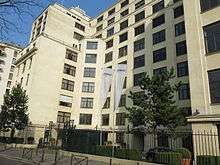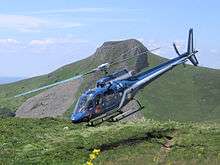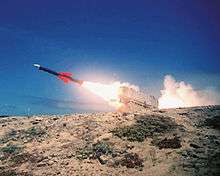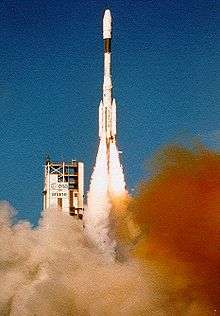Aérospatiale
Aérospatiale[1] (French pronunciation: [aeʁɔspasjal]), sometimes styled Aerospatiale, was a French state-owned aerospace manufacturer that built both civilian and military aircraft, rockets and satellites. It was originally known as Société nationale industrielle aérospatiale (SNIAS). Its head office was in the 16th arrondissement of Paris.[2][3] The name was changed to Aérospatiale during 1970.[4]
| State-owned corporation | |
| Industry | Aerospace and defence |
| Fate | Merged into EADS |
| Predecessor | Sud Aviation Nord Aviation SEREB |
| Successor | EADS |
| Founded | 1970 |
| Defunct | 10 July 2000 |
| Headquarters | Paris, France |
| Products | See list |
During the 1990s, Aérospatiale underwent several significant restructures and mergers. Its helicopter division was, along with Germany's DaimlerBenz Aerospace AG (DASA), combined together to form the Eurocopter Group. In 1999, the majority of Aérospatiale, except for the satellites activities, merged with French conglomerate Matra's defense wing, Matra Haute Technologie, to form Aérospatiale-Matra. That same year, the satellite manufacturing division merged with Alcatel to become Alcatel Space, now Thales Alenia Space. In 2001, Aérospatiale-Matra merged with Spanish aviation company Construcciones Aeronáuticas SA (CASA) and German defense firm DaimlerChrysler Aerospace AG (DASA) to form the multinational European Aeronautic Defence and Space Company (EADS). Currently, the majority of the former assets of the company are part of the multinational Airbus consortium.
History
Formation

During 1970, Aérospatiale was created under the name SNIAS as a result of the merger of several French state-owned companies - Sud Aviation, Nord Aviation and Société d'étude et de réalisation d'engins balistiques (SEREB). The newly formed entity was the largest aerospace company in France. From the onset, the French government owned a controlling stake in Aérospatiale; at one stage, a 97 per cent ownership of the company was held by the government.[5]
In 1971, Aérospatiale was directed by the French industrialist Henri Ziegler; that same year, the firm's North American marketing and sales arm, which had previously operated under the trading name of the French Aerospace Corporation, was officially rebranded as the European Aerospace Corporation, which was stated to better reflect Aérospatiale's increasing focus on collaborative efforts with its European partners.[6]
Major activities
Many of Aérospatiale's initial programmes were hangovers from its predecessors, particularly those of Sud Aviation.[5] Perhaps the most iconic and high-profile of the company's programmes was Concorde, a joint French-British attempt to develop and market a supersonic commercial airliner. Initial work on the project had commenced at Sud Aviation and the Bristol Aeroplane Company, its British counterpart.[5] The engines for Concorde were also developed as an Anglo-French joint effort between French engine firm SNECMA and Bristol Siddeley. However, the programme was highly politicised and encountered considerable cost overruns and delays.[5] Ultimately, negatively affected equally by bad political decision and an oil crisis in the 1970s, only two airlines purchased Concorde.[5]
Aérospatiale's senior management were keen not to repeat the mistakes of the programme to produce Concorde.[5] Their next major effort was would be an international collaborative effort between British Aerospace and West German's aircraft company Messerschmitt-Bolkow-Blohm (MBB). The consortium, called Airbus Industrie, was established with the purpose of building a twin-engined widebody airliner, known as the A300.[5] While at first, it was difficult to achieve sales and the outlook for the A300 looked negative. However, Aérospatiale continued to manufacture the jetliner even without orders for some aircraft as it could not reasonably cut back production as French law required that laid-off employees were to receive 90 percent of their pay for a year as well as to retain their health benefits throughout.[5] Sales of the A300 picked up and the type became a major commercial success for those involved, eventually driving both the American Lockheed L-1011 and the McDonnell Douglas DC-10 from the market due to its cheaper operating model.[5] On the back of this success, further airliners would be produced under the Airbus brand and the company would become a world leader in the field of large commercial aircraft during the 1990s.[5]
Aérospatiale played a leadership in the development of the European space sector.[5] During the 1960s, Sud Aviation had been involved in a multinational European programme to produce the Europa space launch vehicle, being a three-stage rocket with separate stages manufactured in Britain, France, and Germany respectively. However, all of the flight tests conducted were failures; the programme's misfortune has been attributed to there being no central authority responsible for operations, which came about as a result of the issue of workshare having become highly politized.
When Aérospatiale stepped in during 1973, it was determined not to repeat the mistakes of Europa.[5] The company proposed to build a new heavy launch vehicle, which would later be called the Ariane, to take the place of Europea. While other European nations were invited to participate, it would be French officials that would be primarily responsible and make the most important decisions.[5] This approach was agreed upon with several other nations; during 1979, the first Ariane performed its first flight, being an immediate success. With this, the French went on to gain a strong advantage over the United States, which had centred its efforts on the Space Shuttle. However, the in-flight explosion of one of the shuttles in the Challenger disaster during 1986 showed that it was too complex for routine use as a satellite launch platform.[5] Aérospatiale went on to develop more capable versions of the Ariane, which took much of the business of space launches away from the Americans during the 1990s.[5]
Privatisation and mergers
In 1992, German defense company DaimlerBenz Aerospace AG (DASA) and Aérospatiale combined their respective helicopter divisions together to form the Eurocopter Group; ownership in this new entity was shared between the two parent companies.[7]
During the late 1990s, French Prime Minister Lionel Jospin's Plural Left government initiated a policy towards the privatization of Aérospatiale.[8][9] In 1999, the majority of Aérospatiale, except for the satellites activities, merged with French conglomerate Matra's defense wing, Matra Haute Technologie, to form Aérospatiale-Matra.[10] During 2001, Aérospatiale-Matra's missile division underwent a further merger with Anglo-French outfit Matra BAe Dynamics and the missile division of Alenia Marconi Systems to form the multinational MBDA entity.[11][12]
On 10 July 2000, Aérospatiale-Matra merged with Spanish aviation company Construcciones Aeronáuticas SA (CASA) and German defense firm DaimlerChrysler Aerospace AG (DASA) to form the multinational European Aeronautic Defence and Space Company (EADS).[13] EADS would later rebrand itself as Airbus, taking the name of its commercial aircraft division, its primary business.[14][15]
Products

_-_53Fi1931_-_cropped.jpg)
Fixed-wing aircraft
- CM.170 Magister
- CM.175 Zephyr
- Concorde (with British Aircraft Corporation)
- N.262
- N.500
- SE 210 Caravelle
- SN 601 Corvette
- TB 30 Epsilon
- Ludion
Helicopters


.jpg)
- AS 332 Super Puma
- AS 350 Ecureuil/AStar
- AS 355 Ecureuil 2/TwinStar
- AS 532 Cougar
- AS 550 Fennec
- AS 565 Panther
- SA 313/SA 318 Alouette II
- SA 315B Lama
- SA 316/SA 319 Alouette III
- SA 321 Super Frelon
- SA 330 Puma
- SA 341/SA 342 Gazelle
- SA 360 Dauphin
- SA 365/AS365 Dauphin 2
- HH-65 Dolphin
Unmanned aerial vehicles
Missiles

- AS 15 TT
- AS-20
- AS-30
- M1 (missile)
- M20 (missile)
- M45 (missile)
- S1 (missile)
- S2 (missile)
- S3 (missile)
- SS.11
- SS.12/AS.12
- Air-Sol Moyenne Portée
- ENTAC
- Exocet
- Hadès (missile)
- HOT (missile)
- MILAN
- Pluton (missile)
- Roland (missile)
Space-related products

- AMC-5 (satellite)
- Arabsat (satellite)
- Ariane rocket
- Astra 5A (satellite)
- Atmospheric Reentry Demonstrator
- Diamant (rocket)
- Hermes spaceplane (not built)
- Huygens (spacecraft)
- Infrared Space Observatory
- INSAT-1C (satellite)
- INSAT-2DT (satellite)
- Meteosat (satellite)
- Nahuel 1A (satellite)
- Proteus (satellite)
- Spacebus (satellite)
- Symphonie (satellite) (satellite)
- Tele-X (satellite)
- Turksat (satellite)
- Turksat 1A
- Turksat 1B
- Turksat 1C
- Topaze (sounding rocket)
- TV-SAT 1 (satellite)
List of CEOs
- 1970-1973 : Henri Ziegler
- 1973-1975 : Charles Cristofini
- 1975-1983 : général Jacques Mitterrand, the brother of François Mitterrand
- Henri Martre (1983 - 1992)
- Louis Gallois (1992 - 1996)
See also
- Construcciones Aeronáuticas SA
References
Citations
- Gunston 2005, p. 13.
- Who owns whom: Continental Europe, Volume 1. Dun & Bradstreet., 1990. 555. Retrieved from Google Books on 31 August 2011. "SA NATIONALE INDUSTRIELLE AÉROSPATIALE 372 1 . 3724 SA, 37 Boulevard de Montmorency, F-75016 Paris"
- "Offices and facilities" (Archive). Aerospatiale. Retrieved on 31 August 2011. "HEADQUARTERS PARIS Aerospatiale 37, boulevard de Montmorency - 75781 Paris cedex 16 "
- Henri Lluch, L'établissement de Marignane : de la SNCASE à l'Aerospatiale, Éditeur : Aerospatiale, établissement de Marignane, 1991, 185 pages.
- "Sud Aviation and Aérospatiale." centennialofflight.net, Retrieved: 19 February 2018.
- "none". Air Progress: 16. September 1971.
- "A Bit of History: American Eurocopter’s Growth over the Decades." Rotor Journal, No. 83. October/November 2009. p. 33.
- Godsmark, Chris and John Lichfield. "Airbus set for privatisation as France abandons objection." The Independent, 28 August 1997.
- "Déclaration de M. Lionel Jospin, Premier ministre, sur le regroupement d'Aérospatiale-Matra et de Dasa et sur son importance pour la construction européenne dans les domaines de l'aéronautique civile et militaire, Strasbourg le 14 octobre 1999." discours.vie-publique.fr, 14 October 1999.
- "Defense & Aerospace Companies - Volume II." Forecast International, September 2001.
- "History." MBDA, Retrieved: 18 February 2018.
- "Creation of MBDA integration of Europe's missile industry." Airbus, Retrieved: 18 February 2018.
- "Dasa/Aerospatiale Matra Merger Creates European Aerospace Giant." Aviation Week, 15 October 1999.
- "EADS to be renamed Airbus Group." BBC News, 31 July 2013.
- Michaels, Daniel. "How EADS Became Airbus." The Wall Street Journal, 5 January 2014.
Bibliography
- Gunston, Bill (2005). World Encyclopedia of Aircraft Manufacturers, 2nd Edition. Phoenix Mill, Gloucestershire, England, UK: Sutton Publishing Limited. ISBN 0-7509-3981-8.
.jpg)